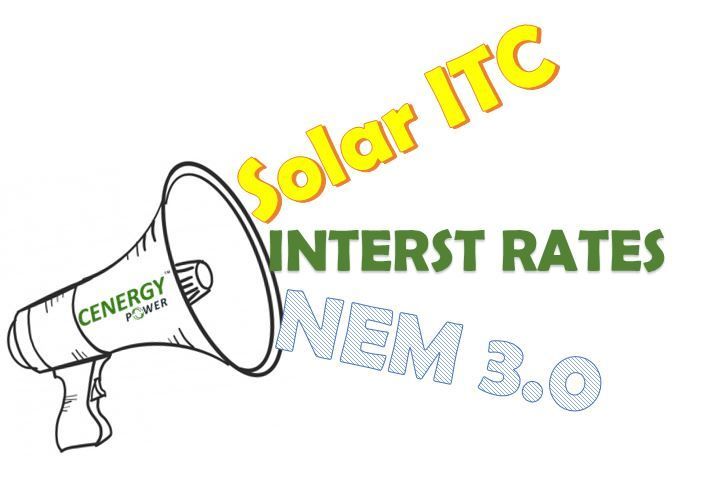Customer Solar Interconnection Filings Ahead of Upcoming Deadlines

As the U.S. solar industry enters the fourth quarter of 2018, Cenergy Power anticipates filing over 40MWs of solar interconnection applications in California before year end at the request of anxious commercial customers focused on getting their projects built and turned on during fiscal year 2019.
This would be a record pace of interconnection filings for Cenergy Power during this fourth quarter period. Based on feedback from our largest customers, we believe the strong pick-up in commercial solar demand is attributable primarily to the following economic considerations that will be in play during calendar year 2019:
- The 30% Investment Tax Credit Steps Down after 2019;
- Net Metering 3.0 will likely take effect by 2020; and
- Interest rates are rising.
The Federal Investment Tax Credit (“ITC”) of 30% will step down after 2019.
In a spending bill passed by Congress in December of 2015, the 30% Federal ITC was extended only through 2019. It is a dollar-for-dollar credit against a project owner’s tax liability. For commercial customers, it will step down to 26% in 2020, 22% in 2021, and 10% permanently after 2021. For homeowners, it will completely phase out in 2022. See figure below.

For a typical 1MWp tracker solar project with a capital cost of $1.5 million, a 4% ITC drop from 2019 to 2020 would equate to a tax credit loss of $60,000. This is the amount that business owners would be required to pay in additional taxes to the federal government if their $1.5 million solar project were to be completed in 2020 instead of 2019.
Net Metering 3.0 will likely take effect by 2020.
California is currently under a Net Metering 2.0 program, which has reduced solar net metering benefits for commercial customers by about 10% compared to the net metering credits provided under the California’s original Net Metering 1.0 program. The next iterative net metering program in California, Net Metering 3.0, will likely reduce net metering benefits by another 10% from Net Metering 2.0 to appease concerns expressed by investor owned utilities that there is too much solar generation during peak sun hours of the day.
Otherwise known as the “duck curve” (see graph below that looks like the shape of a duck), there is a growing trend in deep midday drop-offs of net load after 10am that is coupled with a surge in load demand after 6pm.

Both phenomena are directly linked to the greater impact of increased solar power generation throughout each day, and this is what Net Metering 3.0 will try to address for the benefit of California utilities. According to pv-tech.org, a leading online resource of solar market trends, “by 2019, the [California Public Utilities Commission] expects to have a whole new set of regulatory structures in place [i.e., Net Metering 3.0] that will enlighten the search for finding the right value for rooftop solar and other distributed energy resources.”
If we apply Net Metering 3.0 to our 1MWp tracker example that generates 2,100,000 kWh per year and reduce net metering credits by an assumed 10% or $0.02 per kWh, the loss solar generation value would be about $42,000 per year (as compared to the solar value under Net Metering 2.0).
Interest rates are rising.
Finally, we believe that a third key driver for the increased solar demand we are witnessing is the fact that interest rates are rising. Reuters recently reported that Wall Street bankers expect a total of four rate increases for 2018 and three for 2019. See below recent Fed Funds rate forecast, which shows interest rates rising up to 1% in the near future.

“Although rising interest rates may sound ominous but a healthy economy combined with still relatively low interest rates makes 2018-2019 an ideal year to leverage your solar project and maximize upfront savings,” says Thomas Steinke, President of Jordan Thomas Leasing (Farm Credit’s exclusive leasing agent).
Applying a theoretical 1% increase in annual loan interest rate on a 10-year loan to finance our sample 1MWp project, the project would incur up to $15,000 per year in additional interest charges if the project cost of $1.5 million was fully financed.
Summary.
When we combine the foregoing economic factors at play when customers are weighing whether they should plan to go solar in 2019 as opposed to waiting until 2020, our 1MWp project example shows that total potential savings in favor of a 2019 project could be as much as +$100,000 in the first year.
Coupled with the fact that recent interconnection lead times have averaged about one year for most projects sized at 1MWp or larger, we believe that the strong surge in commercial interconnection filings requested by commercial customers in Q4 2018 will only increase in the next few months.
With little cost and lead time to apply for interconnection, Cenergy hopes to help more commercial customers contemplating a 2019/ 2020 solar project plan for and file their interconnection applications in the near future. This would preserve their ability to have their projects ready for construction and commercial operation in 2019.
For more information on these near-term drivers and benefits of working with Cenergy Power, please contact Nader Yarpezeshkan at Nader@cenergypower.com or (760) 603-1933.
